
Breed report: Berger Picard
The previous preliminary report of the Berger Picard found that they had little biodiversity as a breed. Due to the report being based on about 34 dogs, there was hope that more diversity would be found breedwide on further investigation. So, what did UC Davis’ professor emeritus Dr. Niels Pedersen BS, DVM, PhD find in regard to the Berger Picard in this analysis? The following article summarizes the full breed report written by Dr. Pedersen. You can find the full report here.
How inbred is the typical Berger Picard?
One aspect of the UC Davis canine diversity test is a calculation that estimates how inbred a dog is. This estimate, called Internal Relatedness or IR, is a positive measure from 0 to 1 when a dog is inbred, and a negative measure from 0 to -1 when the dog is outbred. An outbred puppy would inherit genetics from its sire that were very different from those it inherited from its dam. An inbred puppy would inherit many of exact same genetics from both dam and sire. Being outbred reduces the likelihood of known and unidentified recessive genetic diseases expressing in individuals.
So, how inbred or outbred are the individuals in the Berger Picard breed?
From the report:
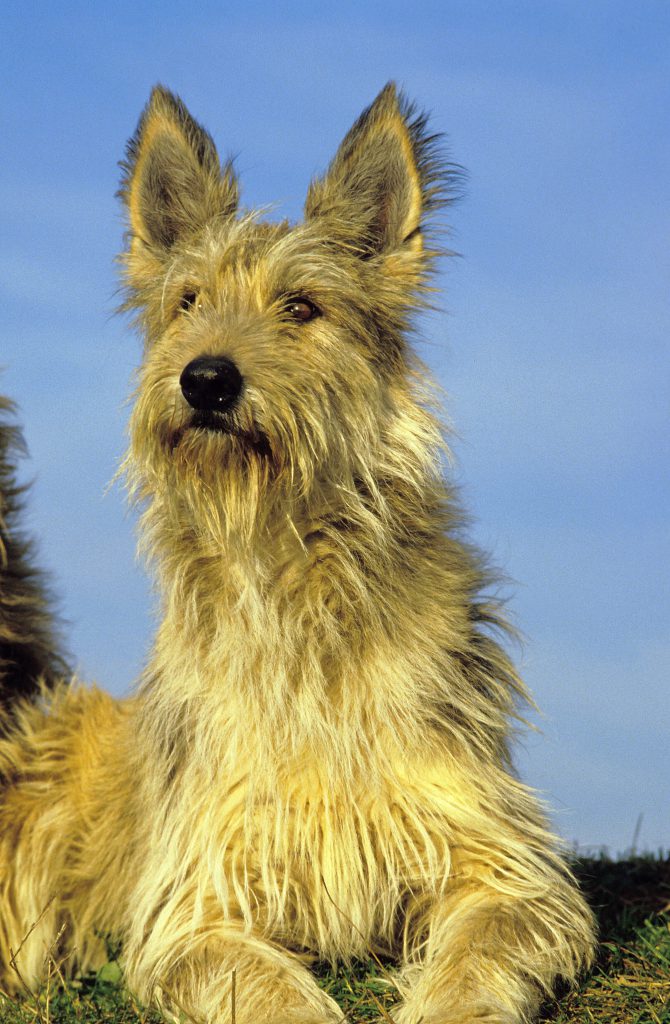
The most outbred dog in the population had an IR score of -0.52, while the most inbred dog in the group had an IR score of 0.39. The mean IR score for the cohort was 0.0053. Therefore, this group appeared to contain small and equal proportions of dogs with parents that were as unrelated (most outbred) or related as possible (most inbred) given the genetic makeup of the population. The existence of both highly inbred and outbred individuals is a typical finding for almost all pure breeds of dogs.
Additionally, Dr. Pedersen further notes later in the report that when adjusted against an ideal population of diverse dogs “Almost all 101 Berger Picard from this cohort have IRVD values of 0.25 or greater (Table 4, Figure 3), which means that if they were found among village dogs, they would all be judged offspring of at least full sibling parents.“
To translate – a portion of the breed has very high levels of inbreeding, and because we can’t necessarily detect this without DNA testing and analysis, they can benefit from predictive software aiding in selection of breeding mates, to ensure that future breedings are not too close, risking health as a result.
How much biodiversity exists in the Berger Picard today?
Dr. Pedersen analyzes the data collected from the VGL canine diversity test in many different ways in order to assess the total amount of biodiversity within each breed. Many of these measures together give us an overall picture of the state of the breed and as a result we can make informed decisions on breed management.
The best explanation I’ve yet read is from BetterBred Founder Natalie, and as a result we will share it again here!
Most breeders think of DNA as coming in two options- a good gene, or a mutant gene – like it is in many DNA tests. In fact, there can be many versions of each gene or (in this case) marker in a single place on the DNA – like a t-shirt that is available in different colors. The more variants there are, the more information we have about the population genetics of a breed. In more inbred breeds, there are fewer variants for each marker. So to use our analogy, an inbred breed might have only a few colors available in t-shirts, whereas a diverse breed will have t-shirts in many colors. Apart from the relatively small number of genes that make up specific, visible breed traits, the rest of the gene pool is generally healthier when there’s a lot of variation for each marker.
Unfortunately when breeders select too strictly for too long and for very specific traits, there can be an unintended loss of variation in the parts of the DNA that thrive with more variation. A good way to assess whether that good variation has been impacted is by using the markers found in the VGL canine diversity test. Because they are considered neutral – or not associated with any specific known trait – they are great for assessing genetic diversity. In breeds with ample diversity, there will be lots of variations for each marker (lots of colors in the t-shirt drawer.)
But what if you have a breed without much variation? Well, this happens, and can happen quite often. In this case the best thing breeders can do is try to make sure the variants that are in the breed are well distributed – so there are plenty of all of them in the breed. Imagine a t-shirt drawer with lots and lots of red t-shirts but only one blue t-shirt and one green t-shirt. If you lose one of the red ones, it doesn’t change much about the t-shirt drawer – there are lots of other red ones. But if you lose either the blue or green one, the variation is seriously diminished. If, on the other hand a third of the shirts are red, and a third are green and a third are blue, then it’s a lot harder to lose the existing variation in the drawer, even if you lose one once in a while, and even though there are only 3 colors.
The Berger Picard’s biodiversity
Another use of an individual’s inbreeding value: we can look at the inbreeding level of all individuals in the breed in aggregate – meaning the whole breed altogether. When a whole breed is very inbred on the same few ancestors, it can result in very little remaining biodiversity within the breed. Then, by adjusting those inbreeding values in comparison to the data from village dogs (the aforementioned “ideal” population for biodiversity), researchers can estimate the remaining biodiversity of a breed compared to all the diversity that once existed in dogs prior to breed formation.
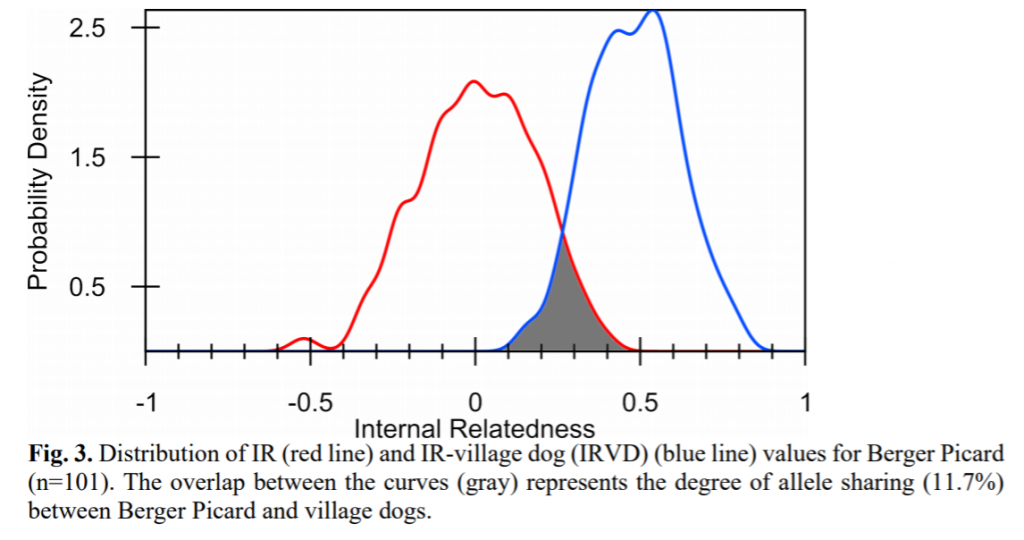
So when this investigation was done for Berger Picard, what did Dr. Pedersen see?
UC Davis VGL Dr. Pedersen 2020
The darkened area in Figure 3 represents the overlap between IR and IRVD curves (11.7%) and is an estimate of the amount of genetic diversity in present-day randomly breeding village dogs that still exists in contemporary Berger Picard. This amount of genetic diversity is less than one half of the retained genetic diversity (25%) found in the comparison with all canids tested at the VGL to date (section IIB).
This assessment indicates that there has been a significant depletion of genetic diversity in this breed compared to the “ideal”, but let’s look at the data another way:
A secondary way to estimate the loss of biodiversity due to breed formation and subsequent breeding choices post-formation is to look at the average number of alleles found at each tested locus and to compare those to all the canines thus far tested at VGL. When looking at the number of alleles found, we might consider two things: the average number of alleles found in total (Na), and the average number of alleles that are effectively contributing to the population (Ne – effective alleles). Going back to the t-shirt analogy above, say we have 10 t-shirts, and 8 of them are red and one is green and one is yellow. The total number of shirt colors is 3, however the majority color is red, therefore our “effective” t-shirt color would be only 1.
So, if we look at these numbers what do we find out about this population?
The average number of alleles (Na) identified in this group of 101 Berger Picard represented 25% of alleles known to exist at each of these loci in all canids tested at the VGL (3.85 out of 15.4). This is the lowest amount of retained canid genetic diversity observed in any breed to date. It is even lower than the retained canid-wide genetic diversity of the Swedish Vallhund (31.9%), Irish Red and White Setter (34.8%) and Flat Coated Retriever (38.6%). It is also less than half of the retained canid genetic diversity of the most genetically diverse breeds such as the Golden Retriever (54.5%), Toy Poodle (55.6%) and Standard Poodle (58%).
UC Davis VGL Dr. Pedersen 2020
The 101 Berger Picard had an average of 3.85 alleles per locus (Na), while the Ne in this group of dogs averaged 2 alleles per locus. This means that 52% of the alleles (2 out of 3.85) found in this cohort accounted for most of the existing heterogeneity (heterogeneity = genotypic variation = phenotypic variation).

This number predicts that the Berger Picard has retained 25% of the existing biodiversity available to canids tested at UC Davis; this number is comparable to the estimate from the IRVD, which estimated a retention of 11.7% of existing biodiversity.
Additionally, Dr. Pedersen discovered that the breed is only effectively using about 52% of its total available biodiversity (Ne/Na) or 52% is contributing to the heterozygosity of the breed. How does a breed community increase this? They identify individuals who may have unusual genetics for the population, and work to preserve those genetics and redistribute them in the population at large.
Breed relationships
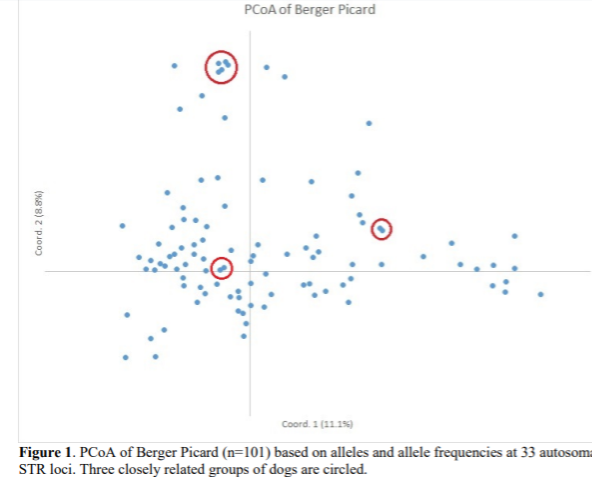
Another use of the data from the VGL canine diversity test is to see how the individuals within the population fit in relation to one another. What do we see when we look at this analysis, called the PCoA graph?
The 101 Berger Picard formed a single population (i.e., a breed) in the PCoA (Figure 1). Individual dogs in the group were reasonably dispersed across all four quadrants of the graph, with the exception of three groups that graphed together and are therefore more closely related than the others (red circles). Several other individuals appeared as outliers from the main population, especially on the right side of the PCoA. Therefore, it can be assumed that this group of 101 dogs (except for these three groups) were as unrelated as possible given the low amount of existing genetic diversity in the cohort.
UC Davis VGL Dr. Pedersen 2020
The breed as a whole seems to have been sampled well, with the exception of likely a few closely related relatives or litters that were tested to aid with selection for the next generation.
Next, Dr. Pedersen chose to compare the Berger Picard with Italian Greyhounds. In this comparison, the Berger Picards segregate tightly with one another.
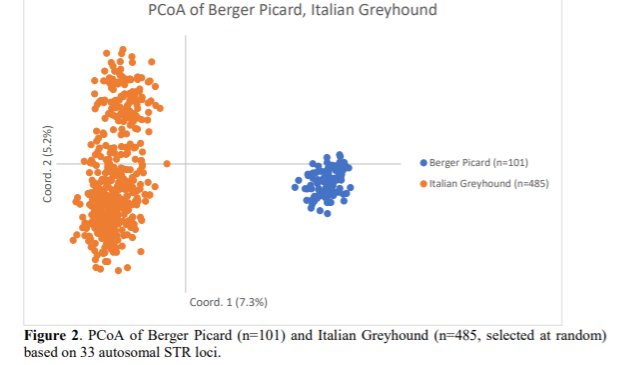
The degree of relatedness of individuals within a breed can be further emphasized by comparing the 101 Berger Picard with genetically distinct breeds, such as the Italian Greyhound (Figure 2). This comparison shows the two breeds to be genetically distinct, as would be expected. However, this type of comparison also accentuates the degree of relatedness of individuals within a breed by grouping them more closely around the XY axis. The greater genetic diversity of the Italian Greyhounds is also apparent, based on the wider dispersal of individual Italian Greyhounds across the graph.
UC Davis VGL Dr. Pedersen 2020
The immune system
The UC Davis VGL canine diversity test can identify more regions of the DLA than any other test available today. The Dog Leukocyte Antigen, called the DLA, is the region of the DNA that codes for the immune system in the dog. There are three regions, Class I, Class II and Class III. This test identifies both Class I and II haplotypes. (A haplotype is a tightly linked group of genes within an organism that is inherited as a group from a single parent.) To learn more about the DLA, read here.
From the report:
Only two DLA class I and two DLA class II haplotypes were identified in the 101 Berger Picard (Table 5). DLAI haplotype 1227 and DLAII haplotype 2067 were both identified in 87% of the dogs tested, and the other two haplotypes occurred at a frequency of 13%. One of the class I haplotypes (1227) was unique to the breed, whereas the three remaining DLA haplotypes were shared with several other breeds (Table 6).
The number of DLA class I and II haplotypes (2 and 2) found in these 101 Berger Picard was the lowest found in a dog breed studied to date.
….
DLAI haplotype number 1227 is unique to Berger Picard among all breeds tested by the VGL, thus reflecting a unique founder line (Table 6). In comparison, the 1052 DLAI haplotype is found in several different breeds tested by the VGL, most commonly in the Shiloh Shepherd and Irish Wolfhound. The 2017 and 2067 DLAII haplotypes are found in several breeds. The 2017 haplotype is particularly common in the Polish Lowland Sheepdog, Shiloh Shepherd, and Magyar Agar, whereas the 2067 haplotype is common in the Shiba Inu.
In summary on the DLA: The Berger Picard has the least biodiversity of any breed in the DLA. Additionally, one of the two types in both Class I and Class II is over-represented. While it’s unclear what this will mean for the Berger Picard, it will be important for breeders to maintain what exists in the DLA for the future.
Conclusions
The following conclusions from Dr. Pedersen sum up the findings from the 101 tested Berger Picard.
(T)he estimated amount of retained genetic diversity for Berger Picard (11.7%) corresponded to approximately half of that of other breeds tested by the VGL (25%). Although this was the lowest diversity of any breed studied to date, breeders have managed the remaining diversity in the best possible manner: standard genetic assessment for heterozygosity and PCoA graphing indicate that the average dog in the population is a product of parents that are as unrelated as possible. However, internal relatedness (IR) scores also show that average values can be misleading, as some individuals were much more inbred or outbred than the breed average.
UC Davis VGL Dr. Pedersen 2020
While the biodiversity of the Berger Picard is the lowest found yet at UC Davis, breeders have been maintaining that biodiversity as well as they possibly can. As time continues, it will be very important that this trend continues.
The most striking finding was the almost total loss of genetic diversity in the DLA regions of the genome. This region is in relatively high linkage, and the two extended haplotypes tend to be inherited by descent, with limited recombination, from each parent. The most likely cause of this pattern of lost DLA diversity is found in the breed history. Registration records showed that Radjah de la Bohème was bred to Wax de la Bohème in early 1950 to produce a fawn male (Yucca des Hauts-Chesnaux) and a brindle female (Yasmina des Hauts-Chesnaux). These two dogs reportedly became important founders of the restored Berger Picard breed [1]. A recent study indicated that the Berger Picard is also closely related to several older Italian herding breeds [6]. Therefore, it can be hypothesized that modern Berger Picard either 1) represent a remnant of a line of dogs that existed prior to the restoration and that shared a unique DLA type resulting from earlier genetic bottlenecks, or 2) result from a very small number of founders that were extensively backcrossed to a specific subpopulation of these founders.
UC Davis VGL Dr. Pedersen 2020
….
The extreme lack of genetic diversity in the DLA class I and II regions identified in the Berger Picard cohort in this study is concerning, but its biological meaning for the genetic health of the breed is uncertain. Certain DLA class I and II haplotypes have been associated with specific autoimmune diseases in certain breeds [8], but autoimmune disorders are not seen as a problem in Berger Picard. Therefore, the strongly shared DLA region of Berger Picard does not appear to have a strong negative effect on self/non-self-recognition. Nevertheless, it is important that breeders maintain as much diversity and heterozygosity in the DLA region as possible.
The recommendation to maintain as much heterozygosity in the Berger Picard in the DLA region will be a tall order for Berger Picard breeders, due to the fact that only two haplotypes have been found in this breed and of those two, one is relatively uncommon. Breeders must also look at the other factors of a breeding, like inbreeding and how typical or atypical a dog is in relation to the breed.
Breeds that lack genetic diversity must be managed much more closely to avoid further loss of diversity, which in turn leads to less leeway to deal with simple recessive or complex polygenic disorders that might arise [10, 11]. Disease mutations are usually autosomal recessive in nature, and in some cases occur in linkage with a region of the genome under strong positive selection for a phenotype that is deemed desirable in the show ring [9-11]. Elimination of such deleterious mutations through selective breeding may result in loss of genetic diversity, especially when diversity is already limited when compared to other breeds as is the case of Berger Picard [9-11].
UC Davis VGL Dr. Pedersen 2020
Based on this report, the Berger Picard has the lowest biodiversity yet tested at UC Davis. Because the Berger Picard enjoys relatively good health, the next steps will be to preserve the diversity that exists in the breed to prevent the rise of a breed specific disease. It will be of great importance to conserve the existing biodiversity so further depletion does not occur due to random loss of alleles – called genetic drift. Breeders can do this by testing their dogs and placing a priority on healthy dogs with less well represented genetics in comparison to the rest of the population, provided they are good representatives of the breed. Using our tools designed to identify these individuals, Average Genetic Relatedness (AGR) and the Outlier Index (OI), breeders can assess these dogs for selection as mates, as well as simulate what to expect in potential litters. Special attention might be warranted to preserve the less typical DLA haplotypes so they are not lost to genetic drift. Breeders should also continue to breed the least related potential mates whenever possible.
Do you own a Berger Picard and want to help insure the preservation of your breed? Click here to test your dog!
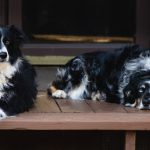 Previous Post
Previous Post Next Post
Next Post


